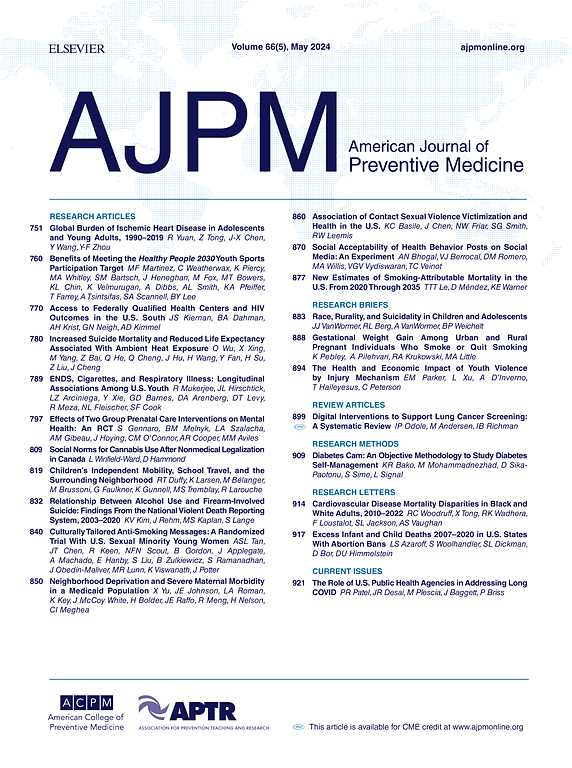Cardiovascular Health Markers With Remote Team-Based Hypertension Management in a Safety-Net Population
IF 4.5
2区 医学
Q1 MEDICINE, GENERAL & INTERNAL
引用次数: 0
Abstract
Introduction
The impact of remote patient monitoring for hypertension on cardiovascular health remains ill defined. This study characterized the association between a remote patient monitoring, team-based hypertension intervention and cardiovascular health markers.
Methods
This retrospective, single-arm cohort study included patients with uncontrolled hypertension enrolled from February 2022 to July 2024 in the ALTA trial (clinicaltrials.gov NCT03713515) at 5 safety-net practices. The ALTA intervention involves remote patient monitoring supported by a virtual clinic managed by a nurse practitioner, a registered nurse, and a community health worker. Demographics, ALTA utilization, and cardiovascular health markers (blood pressure, lipids, glycemic indicators, BMI, and smoking history) at baseline and 12 months were collected. The 5 cardiovascular health markers were scored (0=poor, 1=intermediate, 2=ideal) and summed into a cardiovascular health score. The primary endpoint was a change in the 12-month cardiovascular health score among patients with a baseline score of ≤7. Secondary endpoints included changes in individual non-blood pressure markers among patients with baseline derangements.
Results
Among the 568 included patients (mean age: 56 years), most were female, non-Hispanic Black, and English-speaking individuals. Nurse practitioner visits were more common among females (p=0.04), with no other demographics predicting ALTA utilization. The cardiovascular health score improved from 4.5 to 5.2 (n=196, p<0.001), independent of ALTA utilization. Total cholesterol (n=86, p<0.001), low-density lipoprotein (n=128, p<0.001), and triglyceride levels (n=51, p=0.004) also improved. Hemoglobin A1c (n=195) dropped among patients with ≥1 nurse practitioner visit (p=0.02). Fasting glucose (n=135) and BMI (n=289) decreased in the highest tertile of nurse practitioner visits (p=0.03) and remote patient monitoring (p=0.02), respectively. Finally, 4 of 27 patients quit smoking.
Conclusions
Remote patient monitoring with team-based support was associated with cardiovascular health improvements. However, benefits may depend on the intervention’s utilization.
安全网络人群中基于团队的高血压远程管理心血管健康指标
前言:高血压(HTN)患者远程监测(RPM)对心血管健康(CVH)的影响仍然不明确。本研究描述了RPM、团队HTN干预与CVH标志物之间的关系。方法:这项回顾性单组队列研究纳入了2022年2月至2024年7月在五个安全网实践中参加ALTA试验(clinicaltrials.gov NCT03713515)的未控制HTN患者。ALTA干预包括RPM,由包括执业护士(NP)、注册护士和社区卫生工作者在内的虚拟诊所提供支持。收集基线和12个月的人口统计学、ALTA使用情况和CVH标志物(血压[BP]、血脂、血糖指标、体重指数[BMI]和吸烟情况)。5项评分(0=差,1=中等,2=理想),汇总成CVH评分。主要终点是基线评分≤7的患者12个月CVH评分变化。次要终点包括基线紊乱患者的个体非血压标志物变化。结果:在568例患者中(平均年龄:56岁),大多数为女性,非西班牙裔黑人,讲英语。NP就诊在女性中更为常见(p=0.04);没有其他人口统计数据预测ALTA的使用率。CVH评分从4.5提高到5.2 (n=196, p)。结论:基于团队支持的RPM与CVH改善有关。益处可能取决于干预措施的使用。
本文章由计算机程序翻译,如有差异,请以英文原文为准。
求助全文
约1分钟内获得全文
求助全文
来源期刊

American Journal of Preventive Medicine
医学-公共卫生、环境卫生与职业卫生
CiteScore
8.60
自引率
1.80%
发文量
395
审稿时长
32 days
期刊介绍:
The American Journal of Preventive Medicine is the official journal of the American College of Preventive Medicine and the Association for Prevention Teaching and Research. It publishes articles in the areas of prevention research, teaching, practice and policy. Original research is published on interventions aimed at the prevention of chronic and acute disease and the promotion of individual and community health.
Of particular emphasis are papers that address the primary and secondary prevention of important clinical, behavioral and public health issues such as injury and violence, infectious disease, women''s health, smoking, sedentary behaviors and physical activity, nutrition, diabetes, obesity, and substance use disorders. Papers also address educational initiatives aimed at improving the ability of health professionals to provide effective clinical prevention and public health services. Papers on health services research pertinent to prevention and public health are also published. The journal also publishes official policy statements from the two co-sponsoring organizations, review articles, media reviews, and editorials. Finally, the journal periodically publishes supplements and special theme issues devoted to areas of current interest to the prevention community.
 求助内容:
求助内容: 应助结果提醒方式:
应助结果提醒方式:


